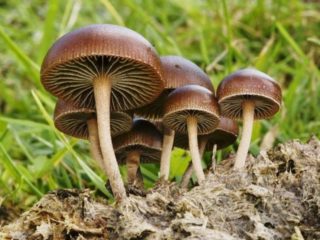Content
Sky blue stropharia is a conditionally edible species with an unusual, bright color. Distributed in deciduous forests throughout Russia. Grows singly or in small groups. Can be found from August to early November. To recognize this representative of the mushroom kingdom, you need to know the external characteristics and be able to distinguish them from their poisonous counterparts.
What does sky blue stropharia look like?
Stropharia sky blue is a beautiful representative of the Strophariaceae family. Since the species has a bright, unusual appearance, it is very difficult to confuse it with other species of the mushroom kingdom.
Description of the cap
The small cap of the sky-blue stropharia, up to 8 cm in diameter, has a cone-shaped shape at an early age, becoming curved over time. The surface is shiny, slimy, and painted in a heavenly emerald color. As it grows, the color fades, and whitish flakes from the blanket that covered the lamellar layer at a young age appear at the edges. Reproduction of sky blue stropharia occurs through microscopic brown spores that are found in dark lilac powder.
Description of the leg
The straight oval leg has fibrous flesh and grows up to 10 cm. In young specimens, the upper part is surrounded by a ring, which disappears with age. The surface is covered with scaly flakes of light gray or sky green color. Dirty white pulp without distinct taste or smell.
Is the mushroom edible or not?
Sky blue stropharia is classified as edibility group 4. Before use, the harvested crop is thoroughly washed and boiled in salted water for 20-30 minutes. Then they can be fried, stewed or preserved for the winter.
But since this specimen has no smell or taste, it has not found wide use in cooking. Also, some sources claim that the fruiting body contains hallucinogenic substances, so mushrooms are not recommended for use by pregnant women and children under 12 years of age.
Interesting facts about sky blue stropharia:
- This representative of the forest kingdom is collected only in Russia and the CIS countries; in other countries the mushroom is considered poisonous.
- Excessive consumption causes visual hallucinations and nervous agitation.
- The hallucinogenic properties are so mild that for them to appear, you need to consume about 1000 g of fresh mushrooms.
Where and how does it grow
Stropharia sky blue grows singly or in small groups from July to October. Loves moist soil or rotting grass substrate, as well as damp, rainy weather. It can be found in parks, along roads and in livestock areas.
Doubles and their differences
Sky blue stropharia, like any forest inhabitant, has edible and inedible counterparts:
- Blue-green – the species is edible, prefers mixed forests. You can recognize it by its lighter cap and small, powerful leg. The pulp without a pronounced mushroom taste, if mechanically damaged, acquires a lemon color. Fruits throughout the warm period.
- crown - an inedible mushroom with whitish dense pulp and a rare taste. This specimen grows on plains or small hills in single specimens. The mushroom has one feature - a change in the color of the cap (from light lemon to dark yellow) and plates (from light purple to black). If a mushroom somehow gets into the basket and then onto the table, mild food poisoning may occur. In order to help the victim in a timely manner, it is necessary to pay attention to signs of intoxication (nausea, vomiting, diarrhea, cold sticky sweat, rapid heartbeat).
Conclusion
Sky blue stropharia is an edible species that prefers to grow in moist soil, among spruce and deciduous trees. The caps of young mushrooms are used for food; after boiling, they are fried, stewed and stored for the winter. In order not to make mistakes during mushroom picking, you need to first familiarize yourself with the characteristics of the species from photos and videos.













